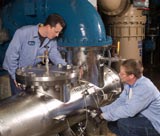
It is now three years since Poughkeepsies' Water Treatment Facility in New York installed six Aquionics' ultraviolet disinfection systems for drinking water treatment.
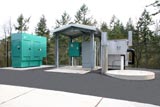
Standby generators lower backup risk
Like many expanding suburbs, Camas, Wash., faced the problem of how to update an aging infrastructure—in particular, its sewage collection system—to meet the needs of the city’s growing population.

On the ocean floor, three miles off the coast of Miami, an underwater city teems with aquatic life and exposes "ruins" from a lost age. A bronze plaque beside a starfish sculpture gives away the fact that while beautiful, this reef is actually artificial.

If you work in the electronic, biomedical, pharmaceutical, cosmetic, energy, catalytic, and materials industries and your employer uses nanoparticles or materials that contain nanoparticles, you may be at risk for exposure.
- By Justin Teeguarden, Amit Gupta, Mark Clark, Sr.
Opinion
The pain caused by high oil prices is nothing like what looms as water, an even more basic and essential natural commodity, faces dwindling supplies and growing demand.

Businesses do business for profit. But today, some businesses are stretching their investment because the market is willing to bear the cost for sustainability.
- By L.K. Williams, EPonline
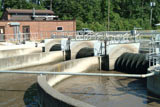
In the early 1990s, Siemens Water Technologies provided the facility with a three-channel Orbal® biological nutrient removal process. In 2004, the plant added a SmartBNR™ control system, a mixed liquor suspended solids (MLSS) recycle pump, and a fourth Orbal channel.
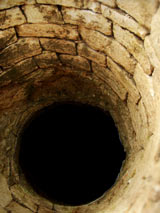
Do you know where your water supply comes from? Does your local government authority send it to your house from a nearby reservoir? Perhaps your district is served by wells? If it is, you are in good company. U.S. Environmental Protection Agency data indicates that more than 90 percent of the 158,000 public water systems use groundwater.
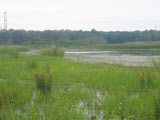
New regulations gave a big boost to the mitigation banking industry recently, meaning good news for the emerging business and its investors. The latest ruling by the U.S. Environmental Protection Agency and Army Corps of Engineers declared mitigation banking to be the preferred alternative for any wetlands mitigation project nationwide.

You invest resources into improving operations to drive EH&S compliance. You build a corporate culture that values safety. You proudly promote yourself as a green company, emphasizing your focus on sustainability and compliance. And then the unthinkable happens -- a spill, an explosion, a deadly fire – something that negates your hard work and shakes the confidence of your entire organization.

Since the early 1990s, U.S. environmental regulations have eliminated the development of mercury as a new product. Despite these changes targeting mercury use, alternatives have been slow to develop, and in cases such as precision measurement devices are not possible. As a result, mercury has been mined through reclamation and recycling processes.

Reverse osmosis (RO) proved the most effective method for treating contaminants such as endocrine disrupting compounds (EDCs) in a four-year study that compared the ability of different contaminant removal technologies.
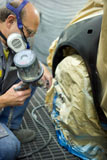
Auto-body shops and restoration specialists can breathe a sigh of relief now that the final EPA rule on emission standards for paint stripping and surface coating operations is out. At the same time, however, they should take a deep breath and prepare for some changes to come.
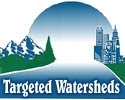
A federal grant program designed to protect and restore U.S. watersheds has doled out $50.7 million over the past five years to projects that range from cleanup of acidic streams polluted by abandoned mine waste to wetlands treatment of a watershed to preserve a fisheries habitat.
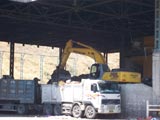
Just outside the city limits of Tel Aviv, Israel, a transformation is taking place. Hiriya, once a waste landfill, is quickly becoming the largest and most advanced environmental center in the country. Today Hiriya is the base for a waste sorting and recycling center as well as a green energy center. Not very long ago, the site was a dump.
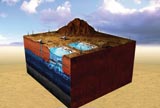
Tucson Water learned critical lessons about water treatment decision-making, customer communication, and public involvement in its first attempt to take its then-500,000 customers from groundwater dependence to surface water supply. The water department is the largest municipal provider in southern Arizona. It applied those lessons in a second attempt that succeeded and soon will be expanded.

In the last 20 years, water quality managers have come to more fully appreciate that the old categories of both management and regulation are breaking down and collapsing in upon themselves. Quantity versus quality, surface versus groundwater, point versus nonpoint sources, chemical versus physical and biological integrity—these are the traditional cookie jars in which we separated management of what is really an integrated resource characterized by the connectivity of all its component parts.

An innovative public/private partnership launched by Northern Utilities is helping to revitalize the city of Lewiston, Maine, and deal with the legacy of pollution from one of the city's old manufacturing sites. Starting in the late 1950s, lower production costs elsewhere led to the closure of many of Lewiston’s textile mills, which were the city’s economic base and once produced one quarter of American textiles.

Due to a recent U.S. Supreme Court case, global warming will be a major air pollution issue this year. Depending upon how the full spectrum of global warming issues is resolved, the impacts may extend to even the smallest air emissions sources. Implementation of the ozone and fine particulate matter ambient air quality standards continues as a major issue in 2008.

Overall, the members of Environmental Protection’s 2008 Environmental Roundtable expect economic advances in the environmental industry, especially in the water treatment and air pollution control sectors. That’s the story these 14 environmental executives told us at our annual roundtable on August 28, and they’re sticking to it.